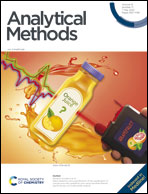A dual-mechanism-driven electrochemiluminescence aptasensor for sensitive detection of β-amyloid peptides†
Abstract
β-Amyloid (Aβ) peptides can bind both Cu2+ and heme cofactors simultaneously to form heme–Cu2+–Aβ complexes, which are proposed to generate toxic partially reduced oxygen species (PROS, e.g., H2O2) and play a vital role in Alzheimer's disease (AD). In this paper, a competitive dual-mechanism-driven electrochemiluminescence (ECL) aptasensor integrating the synergistic enhancement and steric hindrance effect was described for Aβ detection. Specifically, graphite carbon nitride (g-C3N4) as an effective ECL luminescent substrate and Au nanoparticles were sequentially assembled on the Au electrode surface, and then a thiol-modified aptamer for capturing Aβ peptide was attached to the surface of the electrode through the Au–S bond. Aβ peptides were simultaneously incubated with heme and Cu2+, and the forming heme–Cu2+–Aβ complexes were subsequently anchored on the electrode through the specific recognition between the target Aβ and the aptamer. When the concentration of the target Aβ is low, the synergistic enhancement effect arising from K2S2O8 with in situ generated H2O2 is predominant, resulting in an increase in the ECL signal of g-C3N4. In contrast, when the concentration of Aβ is high, the steric hindrance effect generated from heme–Cu2+–Aβ complexes is dominant, leading to a decrease in the ECL signal. The present sensor exhibits a favorable linear response for the detection of Aβ with a relatively low detection limit of 0.24 pM, and provides a more sensitive and selective platform for bioanalysis.



 Please wait while we load your content...
Please wait while we load your content...